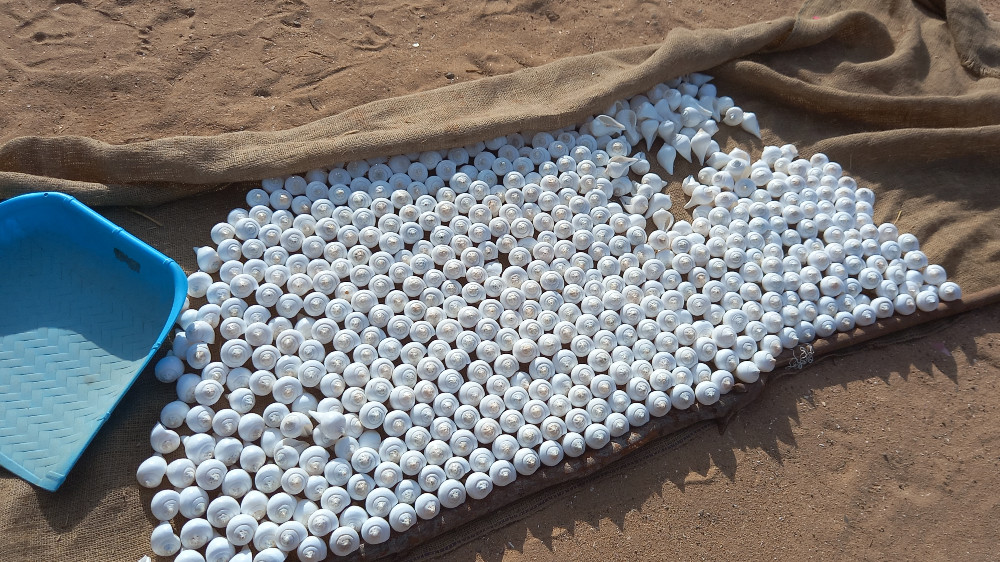Shores to stores: The journey of Dhanushkodi seashells
Despite the proximity to shores and the placid nature of the sea, shell collection comes with its own share of risk and adventure.

CHENNAI: In fishermen's parlance there are two types of kadals (seas) --- Pen kadal (feminine sea) and Aan kadal (masculine sea). Since Dhanushkodi is the culminating point of Bay of Bengal and Arabian sea, this distinction is made by their currents, seasonal changes, and depths. People living on either side choose their trade accordingly.
Muniyappan, a fisherman explains the shell collection philosophy running counter to an age-old Tamil maxim. As opposed to "Kadal aazham kanda periyarum pennin manadhaazham kaana mudiyadhu" (Even the wise who can fathom the depth of the ocean cannot know the depth of a woman's heart), he says, "Pen kadal is not so deep and it is easy to pick shells and cowries from those shores. Usually if one of the shores is tumultuous, the other stays placid." Hailing from the fishermen hamlet of Oththapatti in Dhanushkodi, he belongs to one of the many villages where the inhabitants make their livelihood from fishing and supplement it by collecting seashells.
 Shells being segregated and packed
Shells being segregated and packedInterestingly, even shell-catching involves a net, albeit, a specially made one colloquially termed as ‘Kachcha valai’ or kachcha net. A round-shaped "Boya" (floater), resembling a ball with a chain, which helps trawlers understand the current and winds of the ocean. "We usually start by 7 am to collect shells and cowries, and work till 10am. We don't go too far, so it doesn't take us long to return. On finding the conducive spot to collect shells we lay the net. After we deposit the shells, we go fishing," says Muniyappan.
“The tides are usually stable in the morning, as the day progresses the shells are dragged further away from the shores by the currents," he adds, explaining why mornings are better for shell-collection. Despite the proximity to shores and the placid nature of the sea, shell collection comes with its own share of risk and adventure. “As shells are generally found under the rocks, there is often a danger of getting one’s leg trapped between the rocks or being injured by sharp edges. Some of our women even drifted away into the ocean during such mishaps," says Muniyappan, lest one may assume that shell-collecting is a tame activity.
 Overview of the Oththapatti village in Dhanushkodi
Overview of the Oththapatti village in DhanushkodiThe shells are a lucrative supplementary income for the fisher folk. Cowries are the most popular, but there are also a range of other shells that are used to make trinkets, vases, photo-frames and many other objects. Fishermen compartmentalise the day’s collection into shells and cowries after the catch. This is done as shells are priced according to the sizes and textures on it. A three-day catch alone would suffice to sell it in the market and get a good sum.
"We never turn away fishermen, no matter what their collections are like. Even if they bring shells that are not high in demand, we are considerate to them when it comes to margin-fixing since their income from fishing is paltry and is also dependent on the day’s catch," says R Gandhi of Gandhi Sea Shell Mart in Rameswaram. A shell in its crude form contains particles of the sea creature that inhabited it as well as other aquatic sediments due to which it can’t be marketed in its original form. The shells need to go through an extensive cleaning and polishing process because they are ready to be either sold or repurposed into anything else.
 Kachcha valai
Kachcha valai"The shells are sent through a two-bristled roller machine to ensure a spotless polish. That apart, the shells are cleaned using bleaching powder and are stored in an acid-filled container for 2-3 days. This is how they get a high gloss.” Taking us through the process, Gandhi explains that this process helps preserve the shell for a long time.
Rameswaram seashells are in high demand in several countries. In India, these are especially sought after by buyers in Andhra Pradesh and Karnataka.
"Not a speck of a shell goes to waste. Expert artisans from Kolkata who make shell bangles even use the residue to make earrings or to embellish bangles. Shell collection does not depend on seasons unlike fishing, so even off season, this trade helps the community earn through the year," Gandhi concluded.
Visit news.dtnext.in to explore our interactive epaper!
Download the DT Next app for more exciting features!
Click here for iOS
Click here for Android



